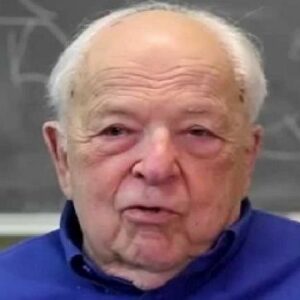Burton Richter is an American physicist who shared the 1976 Nobel Prize in Physics for discovering a new subatomic particle called ‘psi’. He was born in New York City, where his father worked as a textile worker, and he attended the city’s Far Rockaway High School. He continued his schooling at Mercersburg Academy, a private boarding school in Mercersburg, Pennsylvania. He completed his collegiate study at the prestigious Massachusetts Institute of Technology, where he developed an interest in quantum electrodynamics. Stanford University’s superior facilities prompted him to leave the Massachusetts Institute of Technology and join the former, where he worked at the High Energy Physics Laboratory. He collaborated with some of the best scientists of his day and, in addition to his Nobel Prize-winning work, he assisted in the development of the world’s first colliding beam machine. Burton also led the Stanford Linear Accelerator Centre for fifteen years, during which time the department made significant strides.
Childhood & Adolescence
Burton Richter was born in Brooklyn, New York City, on 22 March 1931, to Albert Richter and his wife, Fanny. His father was a textile worker.
Burton attended New York’s renowned Far Rockaway High School. Additionally, Nobel Laureates such as Richard Feynman and Baruch Samuel Blumberg attended the institution. He then attended Mercersburg Academy, a prestigious private boarding school in Mercersburg, Pennsylvania.
After graduating from high school, he enrolled in the Massachusetts Institute of Technology, undecided whether to major in physics or chemistry. He eventually developed an interest in physics and graduated in the field in 1952. He received his doctorate from the same institute four years later.
Burton Richter’s Career
Throughout his years as a student and research researcher at the Massachusetts Institute of Technology, he developed an interest in quantum electrodynamics theories and desired to delve more into the subject.
Burton Richter began his academic career at Stanford University in 1956 as a research associate at the High Energy Physics Laboratory. He made significant contributions to our understanding of electron position pairs and established a new upper bound on the validity of quantum electrodynamics theories.
In 1957, he teamed with G.K. O’Neill, W.C. Barber, and B. Gittelman to develop a colliding beam machine for researching electron-electron scattering at a much larger center of mass. After six years, the project was completed, and the machine WAS the first of its type.
He was designated full professor at Stanford University in 1967. After a lengthy effort to secure funding for the construction of a high-energy electron-positron machine, he was finally granted funding by the US Atomic Energy Commission to construct the Stanford Positron Electron Asymmetric Ring or SPEAR.
He collaborated with David Ritson on SPEAR, which they successfully built-in 1973. However, and maybe more importantly, he used the SPEAR to find a new subatomic particle. He coined the term psi for the particle. Samuel Ting discovered the same thing while working on a separate project.
He was appointed director of SLAC, or Stanford Linear Accelerator Centre, in 1984 and served in that capacity for 15 years. His work on beam dynamics and accelerator physics was particularly noteworthy.
He was on the JASON advisory committee, an independent body of experts that advises the US government on scientific and technological problems. He is currently a member of the board of directors of Scientists and Engineers for America, an organization dedicated to the advancement of good science in the American government.
His Significant Works
Without a doubt, his most significant contribution is the discovery of the subatomic particle psi, which became known as the psi/j meson after another scientist identified the particle concurrently in an unrelated investigation. He was awarded the Nobel Prize in Physics for this achievement.
Awards and Accomplishments
In 1975, he received the Ernest Orlando Lawrence Award.
Burton Richter and Samuel Ting shared the 1976 Nobel Prize in Physics for “pioneering work in the discovery of a new type of heavy elementary particle.”
The US Department of Energy presented him with the Enrico Fermi Award in 2010.
Personal History and Legacies
In 1960, Richter married Laurose Becker. Elizabeth is the couple’s daughter, while Matthew is the couple’s son.
Estimated Net worth
Burton is one of the wealthiest physicists and is included on the list of the most popular physicists. Burton Richter’s net worth is estimated to be $5 million, based on our review of Wikipedia, Forbes, and Business Insider.


